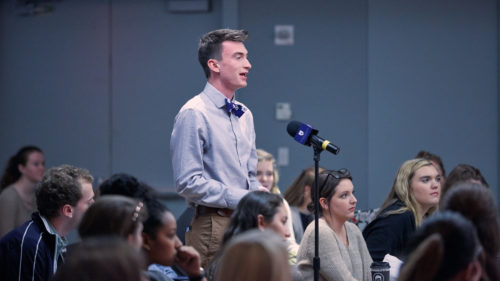52 Broadway: A New York Real Estate Close-Up
Thus far, our series of site histories has reached back as far into the mists of time as knowledge allows, and attempted to fill in as many gaps as possible along the way.

Thus far, our series of site histories has reached back as far into the mists of time as knowledge allows, and attempted to fill in as many gaps as possible along the way until it is time to tell the story of how King’s came into a particular property—and if applicable, what became of it after King’s left.
The story of 52 Broadway[1] begins much as other site histories have, with the Lenape Indians, and is harder to trace. The story of a piece of land in a large city hides more easily behind the corporations and holding companies who conduct the transactions that outline that story—unless, as with the Empire State Building, that parcel was ever owned by someone especially famous, or is notable itself.
In consequence, there is not much we know about this particular spot. The life of early Lower Manhattan, a settlement of yellow brick houses by the Dutch, who used to go ice skating on a pond near Chambers Street, then out in the country, is well chronicled elsewhere, as are its British and early American scenes—rather beautifully in Pete Hamill’s Downtown, if anyone wants recommendations. Today it’s enough to point out that Dutch had a wall across the island intended to keep hostile natives out—now Wall Street. That wall did not define the city’s future; the arterial street running north into the countryside did. Wall Street is iconic in its own right, but Broadway is the city’s aorta, connecting the Battery almost to the Bronx. Broadway is where we find King’s.
There is a story around campus of uncertain origin that John Jay, the Founding Father and first Chief Justice of the United Supreme Court, once resided at 52 Broadway. That would have been the time when George Washington and Alexander Hamilton were regulars at Trinity Church, just up the block, as the idea of America was bustling to life.
It does not appear that 52 Broadway was ever part of the famous land grant to Trinity Church from the British crown, intended to help that church succeed financially. The crown acted wisely; there is nothing more guaranteed to “make it” in Manhattan than real estate holdings. Although Trinity has given away or sold much of its original parcel, it still owns around 14 acres of ground in Manhattan and is supposedly the second-wealthiest church in the entire world[2]. Most of its original grant, though, was to the north of its site at Wall Street and Broadway, which means the space occupied by King’s was most likely not included.
The factors that brought King’s to the Financial District began lining up unbeknownst to the College shortly after 9/11. In 2001, the United Federation of Teachers was maxed out in its Park Avenue South headquarters and looking to move elsewhere. Real estate values were down in Lower Manhattan. In 2002, realty agents Mark Boisi and Neil Lipinski represented the UFT in acquiring 50 Broadway and signing a 32-year lease at 52 Broadway from Jack Resnick & Sons, the owner[3]. The move made headlines at least twice in The New York Times, once as real estate news and once as a speculative analysis of the union’s contract negotiations with the Bloomberg mayoral administration. The UFT likely also benefited from tax incentives being offered by the city at the time for any organization that was moving into the area, and their move was hailed as an example for other companies—a civic service of sorts that would help revive the historic Financial District. Whether the UFT influenced other companies explicitly or not, New York recovers. Sixteen years after 9/11, the area is thick with tourists, bustling with new retail and landmarks, and enjoying an array of food options to satisfy a clientele that no longer vanishes after business hours.
Mr. Lipinski said in a phone interview that 52 Broadway, which houses most of the King’s campus, was built in the late 1800s out of brick, originally U-shaped for light and air circulation in the days before air conditioning. In 1982, the Resnick group had the empty space in the middle of the U built out, an aluminum-type skin added to the building’s façade, and several stories added to the top. The College’s City Room, which is largely uninterrupted by support columns, seems to be part of that build-out, occupying the fifth floor of what used to be thin air. (The 50 building maintains a Roman-styled façade of concrete, brick, and possibly stone.)
The College’s relationship with Mr. Lipinski began around 2010, when a change in the city’s occupancy regulations forced King’s to look for additional student housing beyond the Herald Towers and the Vogue in midtown. Mr. Lipinski was tangentially involved in helping King’s sublet a number of dorm rooms from the School of Visual Arts on Ludlow Street, and later found and secured the residences on Clark Street in Brooklyn, which the College still uses today.
In late 2011, as was recounted last month, King’s was working with the Malkin family on renewing and expanding its campus lease in the Empire State Building—an effort that involved King’s lawyers, Empire State Building lawyers, architects, and all the department heads of the College, in an extensive effort to make sure everyone’s needs were met.Frank Torino, Vice President of Finance at King’s, recalled, “We thought everything was worked out. We thought we had a deal—we were never a day late with the rent and never caused any trouble.” The landlord, however, kept raising issues with various details in the lease. (Lipinski said separately that to him, from his experience as a broker, the Empire State Building contract had all the markers of being destined to fall through—but that, also in his experience, this ending is usually not on tenants’ radar. So it was with King’s.) One day in February, Tony Malkin called Mr. Torino and Duanne Moeller, then the College’s chief administrative officer, and asked them to come to his office on 42nd Street. They went, thinking they were going to sign the lease. Instead, Malkin told them, “I just don’t think I want a college in the Empire State Building.”
Mr. Torino is quick to dispel any suspicions that this move was in any way ideologically motivated. Rather—and Mr. Lipinski reiterated this independently—colleges are not considered desirable tenants from a landlord’s perspective. They create a great deal of foot traffic as students come and go between classes, create congestion in elevators, and often require separate entrances, and so on. Indeed, the lease negotiations with the Empire State Building in 2011 and early 2012 included stipulations about which entrances students could use, how they should access the underground floors, and other rules—a fact Mr. Torino mentioned and the writer remembers from being a student. There are three classes of office buildings in New York City, with A being the highest. It’s not certain what class the Empire State Building was in 2011-12, but it is certain that a Class A office building would never have a college in it, according to Mr. Torino. Since Mr. Malkin was planning to go public with the building, he wanted to maximize its value for a successful initial public offering.
When Malkin made his intentions clear, there was an immediate problem: the lease expired at the end of 2012, and one does not simply up and move an entire educational institution over Christmas break. Torino and Moeller asked for the lease to be extended to June of 2013, and were denied. The compromise the two organizations eventually reached was that if King’s could find another location in the summer of 2012 before the existing lease ended, Mr. Malkin would let them out of it early without having to pay through the end of the year.
Fortunately, says Mr. Lipinski, King’s had already been looking around at other buildings. He had advised the College before this turn of events to look downtown rather than in midtown. Although the College enjoyed its iconic address, downtown was both more affordable and more livable. In fact, prior to the failed Empire State Building renewal, Lipinski had guided the College most of the way through a negotiation for space at 40 Wall Street before its owner—none other than Donald Trump—also backed out of finalizing that agreement. So, as Lipinski tells it, although the College had been stood up by landlords twice by early 2012, King’s was already sold on the idea of a new neighborhood.
Duanne Moeller called Mr. Lipinski after the Malkin meeting and said, essentially, “Help!” Lipinski knew that UFT had vacant space in 52 Broadway and underutilized space in both 52 and 50, none of which was being advertised on the market. He also knew that the floors didn’t line up perfectly but they could be lined up well enough, with some stairs and a hole knocked in the wall between the buildings. Mr. Torino recalls touring the Broadway buildings and seeing that they had classrooms and offices ready for use: the renovations necessary to make it work as a campus would be—compared to starting from scratch in an office building—manageable. So, in the space of six or seven months, with Mr. Lipinski serving as a kind of space planner as well as representing both parties as their realty agent, legal agreements were drawn up and the campus was pieced together and fitted out in time for the students’ return in September. “It was a huge lift,” Mr. Lipinski says. “Huge!” He later negotiated the addition of what is now the O’Keeffe Student Union, beneath the main King’s lobby.
The King’s lobby has its own miniature story. The separate entrance the College enjoys used to be occupied by enormous air conditioning units sitting on the floor, and the space within was leased to Amalgamated Bank, and before that to Dress Barn. The air conditioning units had to be lifted into the ceiling to create the King’s entrance.
Looking back at the seven months between Malkin’s announcement and the start of the 2012-13 school year, Mr. Torino says, “It’s not that exciting five years later, but at the time it was very pressure-packed. Everybody pitched in. And we were all in place by September.”
That is a good summary of the New York real estate experience, whether for a multimillion dollar organization like the UFT or a new college graduate looking for his first apartment share: full of arcane details and somewhat humdrum in the end, but periodically (and reliably!) laden with stress and made workable by relationships along the way. But the results of this particular story were not humdrum at all. God provided a campus with street visibility and abundant windows—something no one who went to school in the Empire State Building’s basement takes for granted—along with luxurious student housing within easy walking distance of campus, in an easy-to-love neighborhood that echoes the future and the past at the same time. The ups and downs of these situations remind us not only that God always provides for His own, but that we are tenants on the earth, where our calling is not to control the fate of mankind, but to bear faithful, joyful witness to the Lord of the universe.
[1] The College’s mailing address is 56 Broadway thanks to a deal negotiated with the Post Office allowing us to have our own designation, but the physical address of the building is 52. Google Maps also reveals that our portion of Broadway is formally designated the “Canyon of Heroes,” meaning King’s could conceivably get away with listing its address as 56 Canyon of Heroes, New York, NY. In this article, we will refer to the buildings composing the King’s campus by their legal/physical addresses, 50 and 52 Broadway (King’s leases space in both buildings). But none of this should deter any readers from using 56 Broadway as the College’s mailing address; it is real, it is approved by the Post Office, and most importantly, it works.
[2] The first, of course, is the Vatican.
[3] In New York City, there are more potential levels to real estate investment than just owning and renting. While the UFT owns 50 Broadway fully, they have what is called a “ground lease” on 52 Broadway. This means they operate the building as if they own it—they are responsible for maintenance and security, are allowed to lease out parts of it to tenants at their discretion, and have two twenty-year options for renewal on the original 32-year lease, making it effectively theirs for 72 years if they so desire—but the dirt that the building stands on is owned by the Resnick development group. The UFT lease also qualifies as a “net lease”—the UFT has just under a ten percent share in the 52 location, receives a corresponding discount on its rent, and will remain a part owner of the property even if it leaves.




